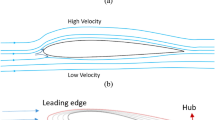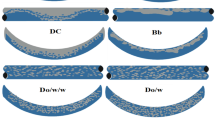Abstract
High static pressure due to flow transitioning associated with recirculation, mixing, and separation around a pipe bend is a possible cause for a decrease in flow efficiency. This paper aims to use edge-tailored guide vanes to ease flow transition and improve flow efficiency, numerically. Here, flow efficiency serves the purpose for qualifying the effectiveness of the proposed technology. Sensitivity studies were performed on the influence of number of guide vane and guide vane thickness in a 45° pipe elbow. In setting up the numerical model for the assumed two-phase flow system (crude oil and water), the volume of fluid model was activated to model time-dependent fluctuations of each interacting phase volume fraction throughout the flow period. Furthermore, the improved delayed detached-eddy simulation turbulence model is employed to resolve the flow features in and outside the wall boundary layer. From the findings, an improvement in flow performance was witnessed using guide vanes. Furthermore, three thin and non-contacting guide vanes were strategically positioned at the center and towards the circumference of the pipe within the bend area, causing an increase in flow efficiency by 78.87%. In addition, the guide vanes played a significant role in limiting turbulence effect to effective flow of the primary phase.
Similar content being viewed by others
References
Abed, N., Afgan, I. 2017. A CFD study of flow quantities and heat transfer by changing a vertical to diameter ratio and horizontal to diameter ratio in inline tube banks using URANS turbulence models. Int Commun Heat Mass Transf, 89: 18–30.
Al-Tameemi, W. T. M., Ricco, P. 2018. Pressure-loss coefficient of 90 deg sharp-angled miter elbows. J Fluids Eng, 140: 061102.
Baker, C., Johnson, T., Flynn, D., Hemida, H., Quinn, A., Soper, D., Sterling, M. 2019. Train Aerodynamics: Fundamentals and Applications. Oxford, UK: Butterworth-Heinemann.
Benhamadouche, S. 2017. On the use of (U) RANS and LES approaches for turbulent incompressible single-phase flows in nuclear engineering applications. Nucl Eng Des, 312: 2–11.
Bíbok, M., Csizmadia, P., Till, S. 2020. Experimental and numerical investigation of the loss coefficient of a 90° pipe bend for power-law fluid. Period Polytech Chem Eng, 64: 469–478.
Dutta, P., Saha, S. K., Nandi, N., Pal, N. 2016. Numerical study on flow separation in 90° pipe bend under high Reynolds number by k-ε modelling. Eng Sci Technol Int J, 19: 904–910.
Ejeh, C. J., Akhabue, G. P., Agyeibi, I. 2019a. Effect of transient temperature on 304 stainless steel LPG tank structure using numerical simulation approach. SN Appl Sci, 1: 1690.
Ejeh, C. J., Akhabue, G. P., Boah, E. A., Tandoh, K. K. 2019b. Evaluating the influence of unsteady air density to the aerodynamic performance of a fixed wing aircraft at different angle of attack using computational fluid dynamics. Results Eng, 4: 100037.
Ejeh, C. J., Boah, E. A., Akhabue, G. P., Onyekperem, C. C., Anachuna, J. I., Agyebi, I. 2020a. Computational fluid dynamic analysis for investigating the influence of pipe curvature on erosion rate prediction during crude oil production. Exp Comput Multiph Flow, 2: 255–272.
Ejeh, C. J., Afgan, I., Shittu, R., Sakirudeen, A., Anumah, P. 2020b. Investigating the impact of velocity fluctuations and compressibility to aerodynamic efficiency of a fixed-wing aircraft. Results Phys, 18: 103263.
Hufnagel, L., Canton, J., Örlü, R., Marin, O., Merzari, E., Schlatter, P. 2017. The three-dimensional structure of swirl-switching in bent pipe flow. ar**v preprint, ar**v: 1710.08357.
Jamal, T., Wang, H., Walters, D. K. 2018. LES and hybrid RANS-LES simulation of a pulsating channel flow. In: Proceedings of the ASME 2018 International Mechanical Engineering Congress and Exposition. American Society of Mechanical Engineers, Pittsburgh, PA, USA.
Khalili, F., Gamage, P., Mansy, H. A. 2018. Verification of turbulence models for flow in a constricted pipe at low reynolds number. ar**v preprint, ar**v:1803.04313.
Lilly, D. K. 1992. A proposed modification of the Germano subgrid-scale closure method. Phys Fluids A Fluid Dyn, 4: 633–635.
Osama, A., Elsayed, K., El-Telbany, M. M. 2017. Pressure loss reduction in U-bend using the adjoint method. In: Proceedings of the International Conference on Aerospace Sciences and Aviation Technology. The Military Technical College, Egypt.
Revell, A., Afgan, I., Ali, A., Santasmasas, M., Craft, T., de Rosis, A., Holgate, J., Laurence, D., Iyamabo, B., Mole, A., et al. 2020. Coupled hybrid RANS-LES research at The University of Manchester. ERCOFTAC Bulletin, 120: 67.
Saha, S. K., Nandi, N. 2017. Change in flow separation and velocity distribution due to effect of guide vane installed in a 90° pipe bend. Mech Mech Eng, 21: 353–361.
Sharma, A., Mallick, S. S. 2021. An investigation into pressure drop through bends in pneumatic conveying systems. Part Sci Technol, 39: 180–191.
Shobayo, O. O., Walters, D. K. 2018. Evaluation of performance and code-to-code variation of a dynamic hybrid RANS/LES model for simulation of backward-facing step flow. In: Proceedings of the ASME 2018 5th Joint US-European Fluids Engineering Division Summer Meeting. American Society of Mechanical Engineers Digital Collection, Montreal, Quebec, Canada.
Valsala, R. R., Son, S. W., Suryan, A., Kim, H. D. 2019. Study on reduction in pressure losses in pipe bends using guide vanes. J Vis, 22: 795–807.
Wu, R., Qin, L. 2019. Numerical study on flow characteristics and energy loss mechanism in the 90° circular pipe bend. In: Proceedings of the 2019 International Conference on Advances in Construction Machinery and Vehicle Engineering. IEEE, Changsha, China.
Acknowledgements
The authors acknowledge the instrumental support of All Nations University and Khalifa University of Science and Technology.
Author information
Authors and Affiliations
Corresponding author
Ethics declarations
The authors declare that they have no conflict of interest.
Rights and permissions
About this article
Cite this article
Ejeh, C.J., Alawwa, F.H., Kofi, A. et al. Improving flow efficiency in curved pipes during multi-phase, immiscible fluid flow using edge-tailored guide vanes. Exp. Comput. Multiph. Flow 5, 122–131 (2023). https://doi.org/10.1007/s42757-021-0121-7
Received:
Revised:
Accepted:
Published:
Issue Date:
DOI: https://doi.org/10.1007/s42757-021-0121-7




